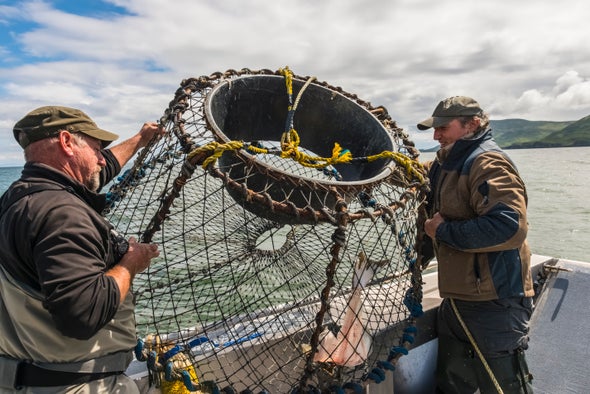A Review of Ocean Acidification and Americas Reponse

Ocean Acidification Threatens the U.S. Economy
A new federal report points to major potential losses in key fisheries and protective coral reefs

Ocean acidification threatens to crusade billions of dollars in damage to the U.South. economy, harming everything from crabs in Alaska to coral reefs in Florida and the Caribbean, NOAA researchers said in a new written report.
Carbon dioxide emissions and ocean acidification are occurring at an "unprecedented" rate, deteriorating valuable fisheries and tourist destinations across the U.s.a. and its territories, NOAA said in a typhoon research programme for ocean acidification.
"Commercial, subsistence and recreational fishing [and] tourism and coral ecosystems" will likely be damaged past ocean acidification, the plan said. Multibillion-dollar fisheries such as West Declension Dungeness crab, Alaska king crab and New England sea scallops are vulnerable. So are Florida'due south coral reefs, an nugget valued at $8.v billion.
Implicating homo activities such as burning fossil fuels, the plan said that ocean acidification "is driven by the growing amount of anthropogenic carbon dioxide absorbed and dissolved in the upper body of water." Ocean acidification makes it hard for some marine organisms such every bit lobsters, oysters and coral to build shells and skeletons.
The 172-page draft research plan draws on hundreds of studies and describes how NOAA will proceed to analyze sea acidification in the 2020s as part of a congressional mandate. The NOAA program is unique in that information technology assesses the threat of ocean acidification nationwide, in dissimilarity to other enquiry that might focus on a specific part of the country.
Two U.S. regions appear particularly endangered: Alaska, with its lucrative seafood manufacture, and the Florida Keys, Puerto Rico and the U.S. Virgin Islands, whose coral reefs attract tourists and protect against flood damage and coastal erosion.
"Alaska waters are especially vulnerable to OA," the research plan said, using the acronym for ocean acidification. Most vulnerable are Alaska communities that rely on subsistence crab harvests and communities with fishing economies.
Alaska'south seafood industry employs more than 50,000 people, pays $2 billion a year in wages, and includes the nation's largest and most valuable crab fishery. It also is an essential part of the state's civilization and identity, which ocean acidification jeopardizes.
"The harvest of marine resources plays a critical role in the identities and well-beingness of Alaska communities," NOAA's research programme said. "More and then than any other Americans, Alaskans rely upon subsistence harvests of marine resources to meet their daily nutritional needs."
In the Florida Keys, Puerto Rico and the Virgin Islands, sea acidification is creating "a keen urgency" because the region features sensitive coral reef ecosystems and commercially important fisheries, NOAA said.
Coral reefs in southeast Florida generate $four.4 billion in annual sales, $2 billion in income, and 70,400 full- and part-time jobs — "much of which will be threatened due to OA's effects on reef-building corals," NOAA said.
Though valued largely for their beauty, coral reefs also "tin can substantially reduce" coastal flooding and erosion by dissipating the free energy of waves striking the shore, NOAA said. An April study by the U.Due south. Geological Survey found that coastal reefs protect economic activity worth $319 million a year in Florida, $118 one thousand thousand a twelvemonth in Puerto Rico and $25 one thousand thousand a year in the Virgin Islands.
NOAA has not officially released its 2020-2029 enquiry plan for sea acidification. A draft became public in December when information technology was posted by NOAA'south Science Advisory Board, whose reviewers called information technology a "brilliant enquiry plan."
"This research plan captures NOAA's extraordinary endeavour to amend the ability to understand, protect, manage, and restore ecosystems that back up salubrious fisheries, increase opportunities for aquaculture, and residual conservation with tourism and recreation," wrote reviewers Joellen Russell of the Academy of Arizona, Irina Marinov of the University of Pennsylvania and Nancy Williams of the Academy of South Florida.
A 2009 federal constabulary requires NOAA to monitor and research the potential furnishings of body of water acidification and to suggest adaptation and conservation steps.
Congress has strongly supported NOAA'due south sea acidification program. The fiscal 2020 budget approved in December provides $fourteen million — more than than double the $6 meg the program got in fiscal 2014.
NOAA's proposed research plan highlights the potential harm of sea acidification forth the Pacific declension and parts of the Atlantic coast. In New England and Mid-Atlantic states as far south every bit North Carolina, the vulnerability to ocean acidification is "high to medium-loftier."
On the Due west Coast, the largest economic damage probable volition occur from Northern California to northern Washington due to "declines in Dungeness crab and groundfish."
But the plan finds dubiousness in other places.
The impacts of sea acidification on fisheries and aquaculture in the southeast Atlantic and Gulf of Mexico "are poorly understood" because research on the issue is "scarce," NOAA said.
In the Great Lakes, which are experiencing acidification fifty-fifty though they are fresh h2o, the potential impacts "are largely unknown at this time," NOAA said.
Reprinted from Climatewire with permission from E&E News. East&East provides daily coverage of essential energy and ecology news at www.eenews.net.
Source: https://www.scientificamerican.com/article/ocean-acidification-threatens-the-u-s-economy/
0 Response to "A Review of Ocean Acidification and Americas Reponse"
Post a Comment